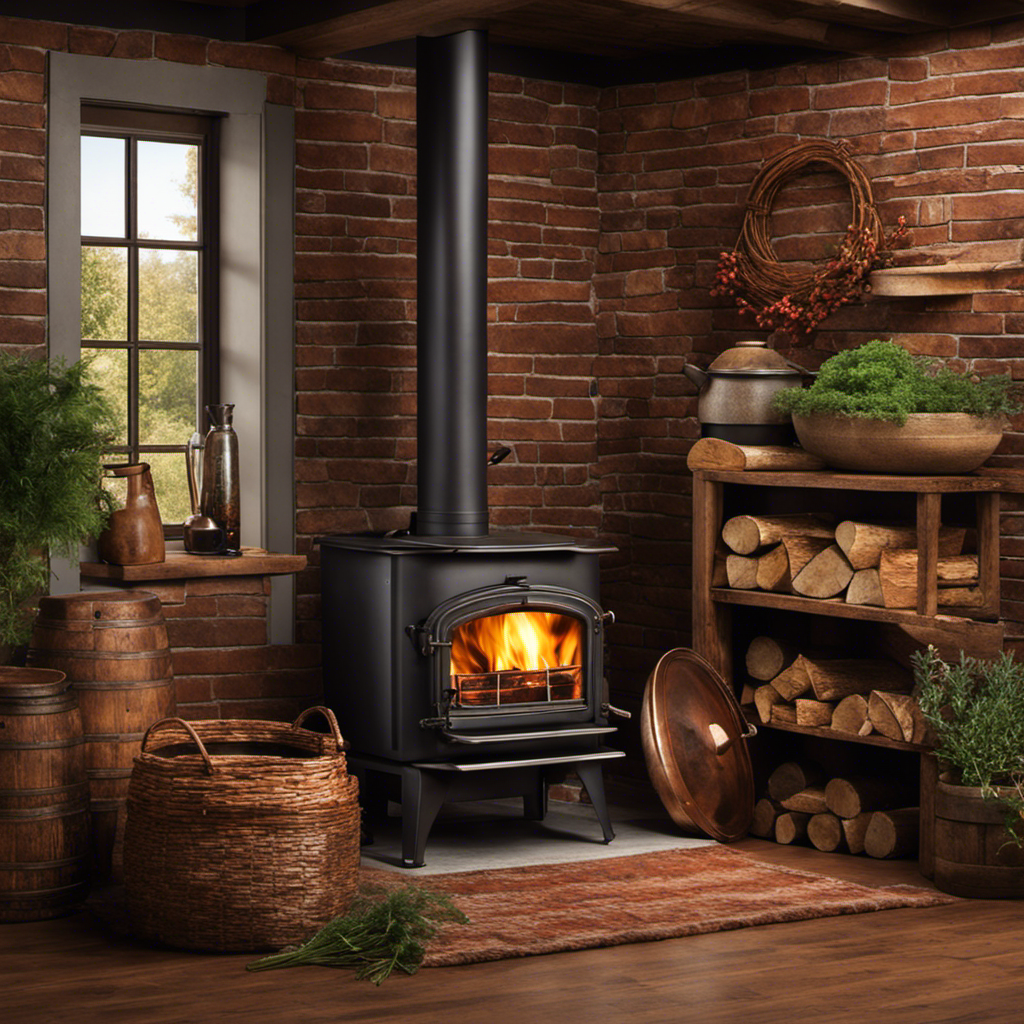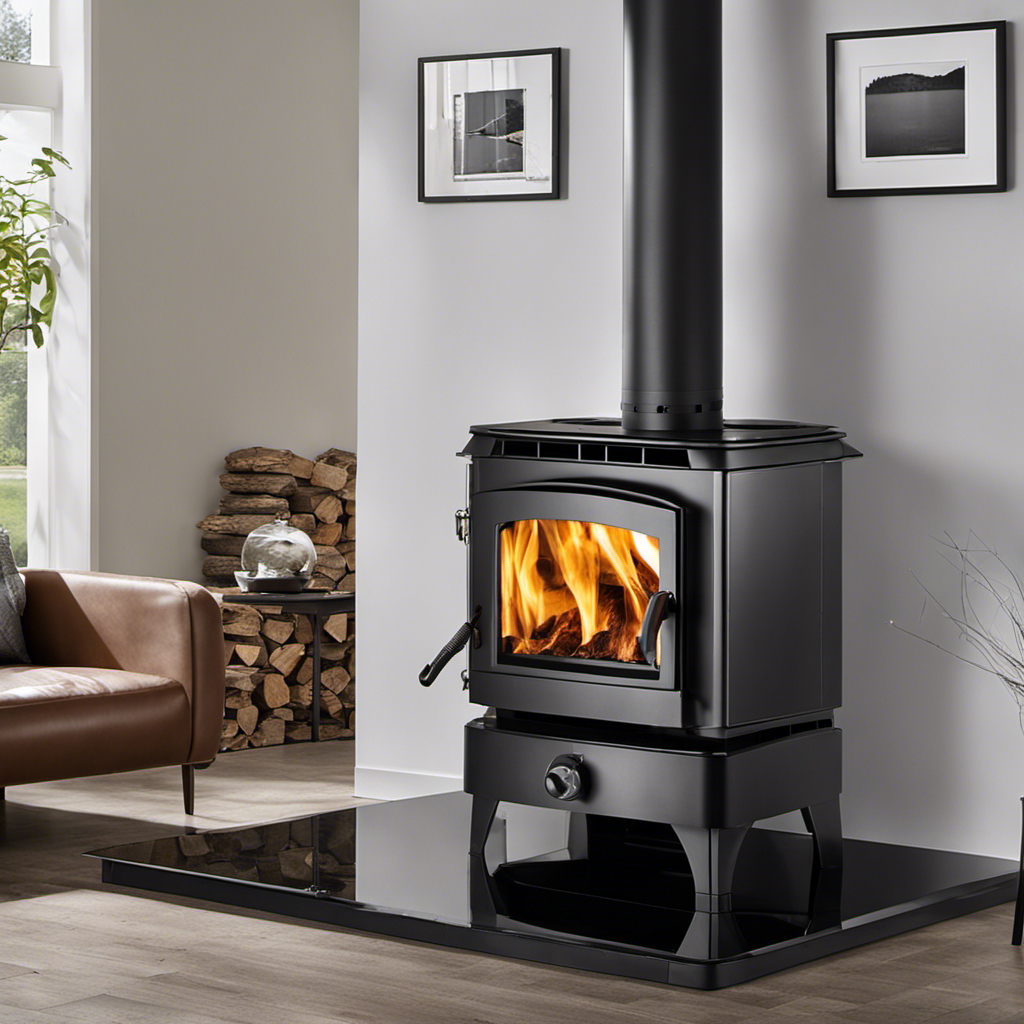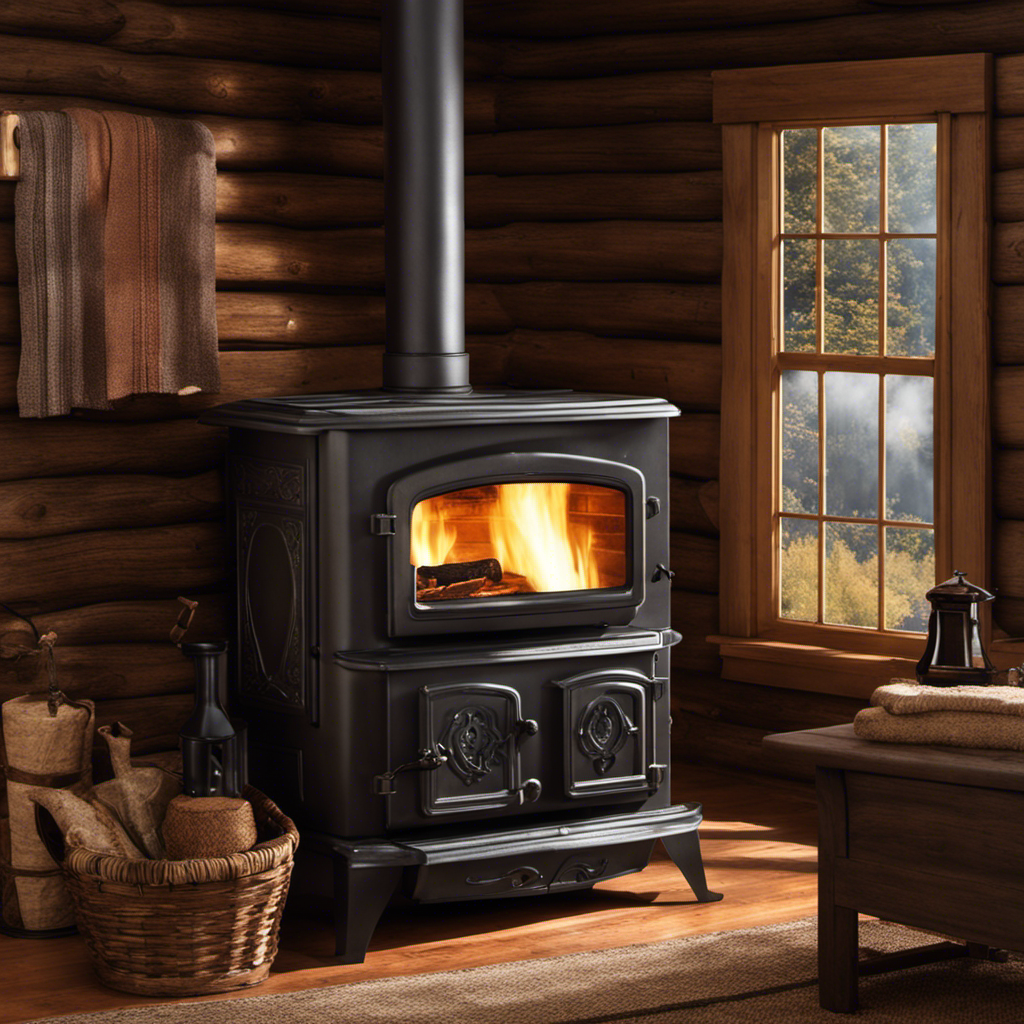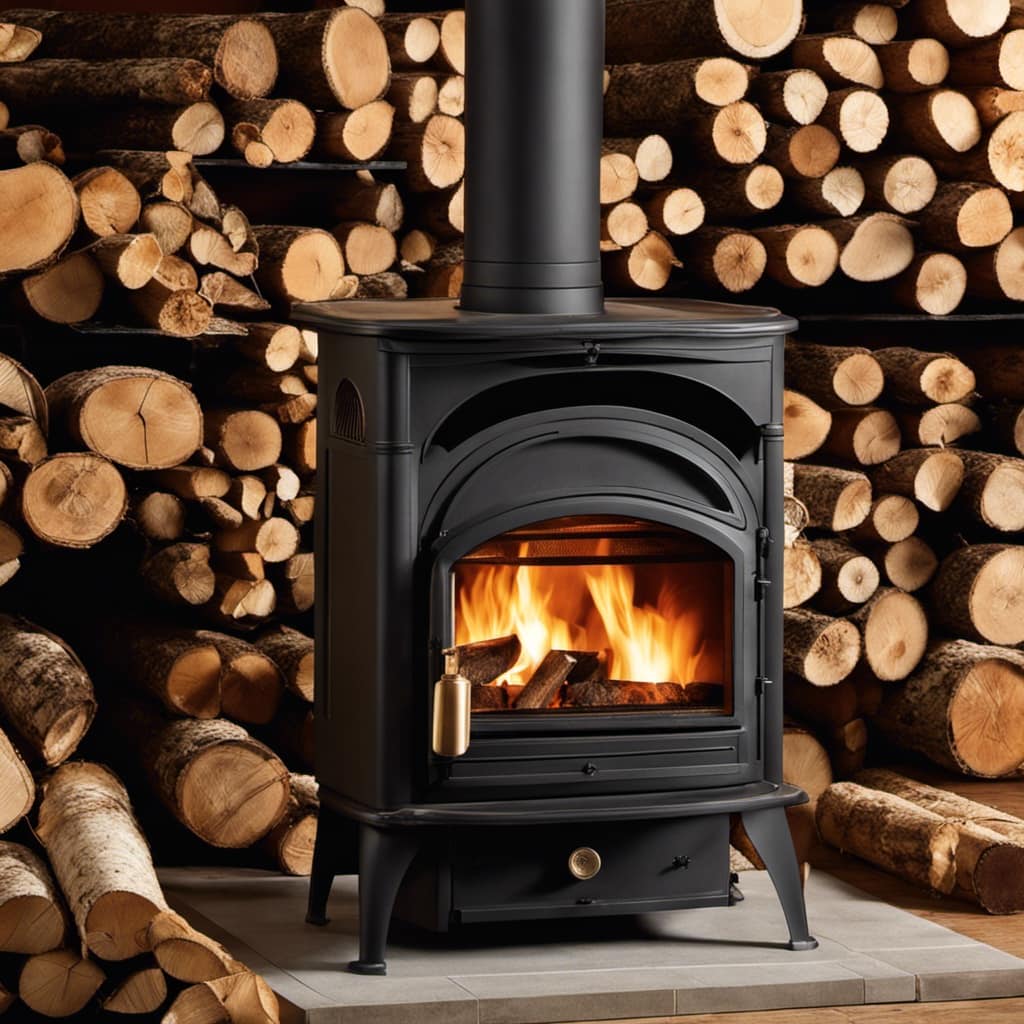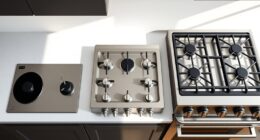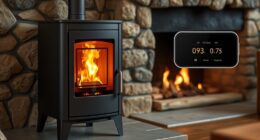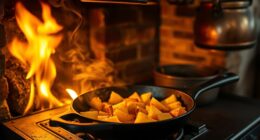As someone who has a wood stove in my home, I recognize the significance of choosing the appropriate materials to place behind it.
A cozy fire is wonderful, but safety is paramount. That’s why I’ve researched and compiled a list of fireproof backing materials, heat shielding options, and non-combustible wall coverings that will protect your home.
Additionally, I’ll delve into insulation and heat barrier solutions, as well as decorative and functional backsplash ideas.
Let’s ensure your wood stove area is both stylish and secure.
Key Takeaways
- Fireproof backing materials such as cement board, fire-resistant drywall, stainless steel sheets, ceramic fiberboard, and metal mesh provide thermal resistance and protect the wall from excessive heat.
- Heat shielding options like heat-resistant tiles, sheet metal, fire-resistant drywall, heat shields, and insulated panels redirect heat away from the wall and provide an extra layer of protection.
- Non-combustible wall coverings including heat resistant panels, stone veneer, brick veneer, tile backer board, and metal backsplash offer excellent fire resistance and add aesthetic appeal to the space.
- Insulation and heat barrier solutions like heat resistant tiles, heat resistant paint, insulation boards, heat reflective panels, and fireproof plaster provide insulation, prevent heat transfer, and reduce the risk of fire.
Fireproof Backing Materials
I’ve found that fireproof backing materials are essential for protecting the wall behind my wood stove. Using fire-resistant materials is crucial for fire safety precautions. These materials are specifically designed to withstand high temperatures and minimize the risk of fire spreading.
One popular option is cement board, which is made of a combination of cement and reinforcing fibers. It’s non-combustible and provides excellent thermal resistance.
Another option is fire-resistant drywall, which is constructed with special additives that make it resistant to flames and heat.
Additionally, stainless steel sheets can be used as a protective barrier. They’re durable, easy to clean, and can withstand extreme temperatures.
Heat Shielding Options
As a homeowner, I’m considering different options for heat shielding behind my wood stove. When it comes to fireplace accessories and hearth protection, it’s important to choose the right materials to ensure safety and prevent any potential fire hazards. Here are some heat shielding options to consider:
-
Heat-resistant tiles: These tiles are designed to withstand high temperatures and can be placed directly behind the wood stove.
-
Sheet metal: A cost-effective option, sheet metal can be installed as a heat shield to protect the wall from excessive heat.
-
Fire-resistant drywall: This type of drywall is specifically designed to resist fire and can provide an additional layer of protection.
-
Heat shields: These shields are typically made of stainless steel or other heat-resistant materials and are placed on the wall behind the wood stove to redirect heat away from the wall.
-
Insulated panels: These panels are designed to provide both heat insulation and protection against fire.
Considering the importance of safety and protection, it’s crucial to choose non-combustible wall coverings that can withstand the heat generated by a wood stove.
Non-Combustible Wall Coverings
To ensure safety and prevent fire hazards, it’s essential to choose non-combustible wall coverings that can withstand the high temperatures produced by a wood stove. One popular option is heat resistant panels, which are specifically designed to handle the intense heat. These panels are made from materials such as cement board or ceramic fiberboard, both of which have excellent fire resistance properties. Another great choice is stone veneer, which not only adds a touch of elegance to your space but also provides excellent heat protection. Stone veneer is made from natural stone or manufactured stone, and it can handle the extreme temperatures without any issues. Here’s a table showcasing the different non-combustible wall coverings and their features:
| Wall Covering | Material | Heat Resistance |
|---|---|---|
| Heat Resistant Panels | Cement Board, Ceramic Fiberboard | High |
| Stone Veneer | Natural Stone, Manufactured Stone | High |
Choosing one of these non-combustible wall coverings will give you peace of mind knowing that your wood stove is surrounded by materials that can handle the heat and keep your home safe.
Insulation and Heat Barrier Solutions
I use insulation and heat barrier solutions to protect the surrounding area from the high temperatures produced by my wood stove. It’s important to take precautions to prevent any heat-related accidents or damage. Here are some effective options to consider:
-
Heat resistant tiles: These tiles are designed to withstand high temperatures and can be installed behind the wood stove to provide a protective barrier.
-
Heat resistant paint: This special type of paint is formulated to handle extreme heat and can be applied to the wall behind the wood stove. It not only protects the wall but also adds a decorative touch.
-
Insulation boards: These boards are made from materials like mineral wool or fiberglass and can be placed behind the wood stove to provide insulation and prevent heat transfer to the surrounding area.
-
Heat reflective panels: These panels are designed to reflect heat away from the wall, reducing the risk of fire or damage.
-
Fireproof plaster: This plaster is resistant to high temperatures and can be used to create a protective layer behind the wood stove.
Decorative and Functional Backsplash Ideas
I’m considering different decorative and functional backsplash ideas to enhance the aesthetic appeal and practicality of my kitchen space.
When it comes to creative design inspiration, there are endless possibilities for backsplash materials and styles. One idea that caught my eye is using patterned ceramic tiles to add a pop of color and visual interest to the area behind my stove.
Another option is a stainless steel backsplash, which not only looks sleek and modern but also provides a durable and easy-to-clean surface.
As for DIY installation tips, it’s important to start with a clean and smooth surface, and to carefully measure and cut the tiles or panels to fit. Using a strong adhesive and following the manufacturer’s instructions will ensure a secure and long-lasting installation.
Frequently Asked Questions
Can I Use a Regular Drywall as a Heat Shield Behind My Wood Stove?
Yes, using regular drywall as a heat shield behind a wood stove is not recommended. It is important to use heat resistant materials, such as ceramic tiles or sheet metal, to prevent potential fire hazards.
What Are the Advantages of Using a Non-Combustible Wall Covering Compared to Other Materials?
Using a non-combustible wall covering behind a wood stove has several advantages. It provides superior fire protection, prevents heat transfer, and enhances safety. Materials like brick, stone, or metal are ideal choices for heat resistance.
Do Heat Barrier Solutions Help Improve the Efficiency of a Wood Stove?
Yes, heat barrier materials and insulation techniques can greatly improve the efficiency of a wood stove. They help to prevent heat loss and direct the heat towards the desired area, making the stove more effective in heating the space.
Are There Any Specific Safety Regulations or Guidelines to Follow When Installing a Decorative Backsplash Behind a Wood Stove?
When it comes to installing a decorative backsplash behind a wood stove, it’s important to follow safety regulations and guidelines. These measures ensure proper protection and prevent any potential hazards.
Can I Use a Heat-Resistant Paint to Create a Decorative Design on the Wall Behind My Wood Stove?
Yes, I can use heat-resistant paint to create a decorative design on the wall behind my wood stove. It’s a great way to add a personal touch while ensuring safety and protection from the heat.
Conclusion
In conclusion, when it comes to what to put behind a wood stove, it’s important to prioritize safety and functionality.
Choosing fireproof backing materials, heat shielding options, non-combustible wall coverings, and insulation and heat barrier solutions can help protect your home and prevent any potential fire hazards.
Additionally, incorporating decorative and functional backsplash ideas can add a touch of style to your wood stove area.
Stay informed and ensure that your wood stove setup is both efficient and secure.
Growing up surrounded by the vast beauty of nature, Sierra was always drawn to the call of the wild. While others sought the comfort of the familiar, she ventured out, embracing the unpredictable and finding stories in the heartbeat of nature.
At the epicenter of every remarkable venture lies a dynamic team—a fusion of diverse talents, visions, and passions. The essence of Best Small Wood Stoves is crafted and refined by such a trio: Sierra, Logan, and Terra. Their collective expertise has transformed the platform into a leading authority on small wood stoves, radiating warmth and knowledge in equal measure.

